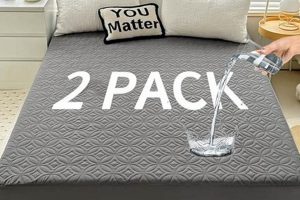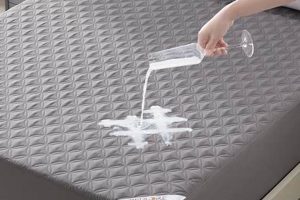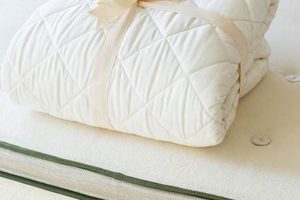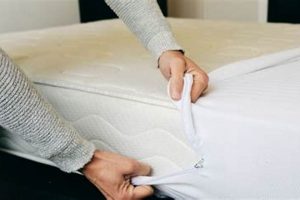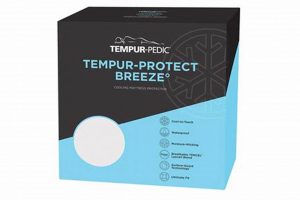These encasements are specialized textile products designed to completely cover a mattress. Functionally, they serve as a barrier, preventing the entry or exit of Cimex lectularius, commonly known as bed bugs. For example, a zippered enclosure made of tightly woven fabric will trap existing infestations within the mattress, ultimately leading to their demise due to starvation, and simultaneously prevents new infestations from taking hold within the mattress itself.
The utilization of such protective measures offers several significant advantages. Firstly, they safeguard the considerable financial investment represented by a mattress, avoiding the costly necessity of replacement in the event of an infestation. Secondly, they contribute to improved sleep hygiene by eliminating a primary harborage for these pests, reducing the likelihood of bites and the associated discomfort. Historically, the development of these products marks a significant advancement in proactive pest management, offering a non-toxic alternative to chemical treatments that can pose risks to human health and the environment.
The subsequent discussion will delve into the crucial factors to consider when selecting a suitable product, examine the different materials and construction methods employed in their manufacture, and outline best practices for installation and ongoing maintenance, thereby ensuring optimal efficacy and longevity.
Essential Considerations for Effective Bed Bug Mitigation
The selection and implementation of mattress encasements are critical steps in managing and preventing bed bug infestations. Proper usage significantly enhances their protective capabilities.
Tip 1: Material Selection: Prioritize tightly woven fabrics with pore sizes too small for bed bugs to penetrate. This is paramount for effective containment and exclusion.
Tip 2: Zipper Integrity: Examine the zipper closure for secure sealing. Bed bugs can exploit even minute gaps. Consider models with zipper locking mechanisms.
Tip 3: Seam Construction: Assess seam construction quality. Internally bound seams or those reinforced with additional fabric layers offer enhanced durability and prevent bug passage.
Tip 4: Comprehensive Encasement: Ensure complete encasement of the mattress. All sides must be covered, leaving no exposed areas for potential entry or exit.
Tip 5: Regular Inspection: Conduct routine inspections of the encasement for tears, punctures, or zipper malfunctions. Promptly address any damage to maintain efficacy.
Tip 6: Compatibility with Bedding: Choose bedding materials that are easily washable and dryable at high temperatures. This complements the protective function of the encasement.
Tip 7: Professional Installation: If unsure about proper installation, seek guidance from a pest control professional. Correct fitting is essential for optimal performance.
Adhering to these guidelines will maximize the protective benefits, contributing to a more secure and hygienic sleeping environment. Selecting high-quality materials and maintaining the encasement are critical for sustained effectiveness.
The following section will address common misconceptions and provide additional resources for comprehensive bed bug management strategies.
1. Barrier protection effectiveness
Barrier protection effectiveness is paramount in the context of mattress encasements designed to mitigate bed bug infestations. The degree to which these encasements physically prevent bed bugs from entering or escaping a mattress directly dictates their utility and long-term success in pest management.
- Material Permeability and Pore Size
The fabric’s weave density and resulting pore size are critical determinants of barrier effectiveness. Tightly woven materials, such as those with pore sizes below 10 micrometers, preclude the passage of adult bed bugs, nymphs, and eggs. The selection of materials with demonstrated low permeability is essential for effective containment.
- Seam Construction and Integrity
Even with highly impermeable materials, weak points at seams can compromise the barrier. Reinforced seams, internally bound edges, and robust stitching are crucial for preventing bed bugs from exploiting these vulnerabilities. Regular inspection for seam integrity is a necessary maintenance practice.
- Zipper Closure Systems and Locking Mechanisms
The zipper represents a potential breach point in the encasement. High-quality zippers with tight closures and integrated locking mechanisms are necessary to maintain an effective barrier. These mechanisms prevent accidental opening and reduce the risk of bed bugs escaping or entering through the zipper.
- Durability and Resistance to Damage
The long-term effectiveness of the barrier depends on its durability and resistance to physical damage. Materials must withstand regular use, washing, and potential abrasions without compromising their structural integrity. Regular inspections and prompt repairs are essential for maintaining optimal barrier function.
The combined effect of these facets directly influences the ability of mattress encasements to provide reliable and lasting barrier protection against bed bugs. Selecting products with attention to these details is crucial for effective bed bug management strategies.
2. Fabric pore size
Fabric pore size is a critical determinant of efficacy in bed bug mattress protectors. The primary function of these protectors is to create an impenetrable barrier, preventing bed bugs from accessing the mattress. A fabric with an excessively large pore size permits the passage of bed bugs, rendering the protector ineffective. The inverse relationship dictates that smaller pore sizes correlate directly with increased protection. For example, woven fabrics with pores exceeding 10 micrometers may allow bed bug nymphs and eggs to penetrate, leading to continued infestation. Selecting a protector with a rigorously tested and documented pore size is therefore essential.
The practical significance of understanding fabric pore size is evident in both preventative and reactive bed bug management. In a preventative context, incorporating mattress protectors with small pore sizes into bedding ensembles can forestall infestations. In reactive scenarios, where a mattress may already harbor bed bugs, encasements with appropriate pore sizes can trap the existing population, eventually leading to their starvation and death. Moreover, the pore size also influences breathability; excessively tight weaves may compromise airflow and lead to discomfort, necessitating a balance between protection and user experience. The construction and material composition also influence the long-term performance of the fabric.
In summary, fabric pore size is a non-negotiable aspect of bed bug mattress protector selection. While seemingly minute, this characteristic has a profound effect on the protector’s ability to perform its intended function. The challenge lies in identifying products that accurately represent their pore size specifications and maintain their integrity throughout the lifespan. Vigilant consumers will prioritize protectors with documented pore size data and verified construction methods to ensure long-term protection from bed bug infestations.
3. Zipper locking mechanism
The zipper locking mechanism on bed bug mattress protectors represents a critical defense against infestation. The fundamental purpose of these protectors is to encase the mattress entirely, creating an impenetrable barrier. The zipper, however, poses a potential vulnerability if it can be easily opened or if the teeth do not mesh together tightly enough to prevent the passage of minute pests. A locking mechanism mitigates this risk by physically securing the zipper pull, preventing accidental opening or intentional tampering. For example, a protector with a substandard zipper, even if made of otherwise impermeable material, is rendered ineffective if bed bugs can infiltrate through a gap in the closure.
The implementation of zipper locking mechanisms varies across different products. Some employ a simple Velcro flap that covers the zipper pull, while others use more sophisticated designs involving clips or interlocking components. The effectiveness of each design hinges on its ability to withstand repeated use and stress without failing. Real-world examples demonstrate that protectors lacking a robust locking mechanism are more prone to bed bug infestations, even when the main fabric of the protector remains intact. The selection of protectors with durable and reliable locking mechanisms is therefore a critical step in ensuring long-term protection. Furthermore, proper installation of the protector, ensuring the zipper is fully closed and locked, is essential for realizing its intended benefits.
In summary, the zipper locking mechanism is an indispensable component of effective bed bug mattress protectors. It addresses a key vulnerability point, ensuring that the entire mattress is securely encased. Selection of protectors with robust and reliable locking mechanisms, coupled with proper installation and maintenance, is crucial for achieving the desired level of protection against bed bug infestations.
4. Seam integrity quality
Seam integrity quality is a critical, yet often overlooked, aspect of bed bug mattress protectors. Even the most impermeable fabric is rendered ineffective if the seams, where fabric panels are joined, are weak or poorly constructed. These areas represent potential entry points for bed bugs, undermining the protector’s intended function.
- Stitch Density and Type
High stitch density, measured as stitches per inch, contributes significantly to seam strength and reduces the likelihood of gaps forming. Lockstitch patterns, for example, offer superior resistance to unraveling compared to chain stitch. The type of stitch employed directly impacts the seam’s ability to withstand stress and prevent bed bug penetration.
- Seam Reinforcement Methods
Reinforced seams, often achieved through the use of binding tape or additional layers of fabric, provide enhanced durability. These reinforcements distribute stress across a wider area, reducing the concentration of force on individual stitches. The presence of seam reinforcement directly correlates with the protector’s ability to maintain its barrier function over time.
- Thread Material and Strength
The material composition and tensile strength of the thread are crucial. Synthetic threads, such as polyester or nylon, offer greater resistance to abrasion and degradation compared to natural fibers like cotton. High-tensile strength thread ensures that the seams can withstand the forces exerted during normal use, laundering, and potential bed bug activity.
- Manufacturing Quality Control
Rigorous quality control measures during manufacturing are essential for ensuring consistent seam integrity. This includes regular inspection of stitch quality, seam strength testing, and adherence to established sewing standards. Protectors manufactured under stringent quality control protocols demonstrate a higher likelihood of performing as intended.
The collective impact of these facets directly influences the ability of a bed bug mattress protector to provide reliable, long-term defense against infestation. Attention to seam integrity quality is paramount when selecting a protector, as it represents a critical line of defense against bed bug intrusion.
5. Allergen reduction capabilities
Allergen reduction capabilities represent a secondary, yet significant, benefit of bed bug mattress protectors. While their primary function is to prevent bed bug infestations, the encasement process inherently limits the accumulation and dispersal of common allergens within the mattress.
- Dust Mite Barrier
Mattress protectors form a physical barrier against dust mites, a primary source of indoor allergens. By preventing dust mites from colonizing the mattress, the protector reduces the concentration of dust mite allergens in the sleeping environment. This is particularly relevant for individuals with asthma or allergies to dust mites, as it can alleviate respiratory symptoms and improve sleep quality.
- Pet Dander Containment
Pet dander, another common allergen, can accumulate in mattresses over time. Bed bug mattress protectors effectively contain pet dander, preventing its dispersal into the air. This is beneficial for pet owners who experience allergic reactions to pet dander, as it reduces exposure to this allergen in the sleeping area.
- Mold Spore Inhibition
Mattresses can provide a breeding ground for mold spores, especially in humid environments. While not designed specifically as mold inhibitors, mattress protectors can reduce moisture accumulation within the mattress, thereby inhibiting mold growth and the release of mold spores into the air. Proper ventilation is crucial to reduce moisture.
- Dead Skin Cell Containment
Humans shed dead skin cells continuously, which accumulate in mattresses and serve as a food source for dust mites. By encasing the mattress, protectors contain these skin cells, reducing the food source available to dust mites and indirectly reducing allergen levels. Regular washing of bedding further enhances this effect.
The collective action of these mechanisms contributes to a reduction in overall allergen levels within the sleeping environment. While bed bug mattress protectors are not a substitute for comprehensive allergen control measures, they provide a valuable adjunct by minimizing allergen accumulation within the mattress itself. Selecting protectors with certified allergen-reducing properties can further enhance this benefit.
Frequently Asked Questions
The following addresses common inquiries regarding the selection, implementation, and maintenance of mattress protectors specifically designed to mitigate bed bug infestations.
Question 1: What constitutes an effective material for bed bug mattress protectors?
Effective materials are characterized by tightly woven fabrics with pore sizes smaller than the smallest nymph stage of bed bugs, typically below 10 micrometers. Materials should also exhibit durability and resistance to tearing or puncture.
Question 2: How critical is the zipper closure in preventing bed bug infestations?
The zipper closure is a critical component. A robust zipper, ideally equipped with a locking mechanism, is essential to prevent bed bugs from entering or escaping through this potential point of weakness. Gaps or compromised zippers render the protector ineffective.
Question 3: What cleaning and maintenance procedures are recommended for bed bug mattress protectors?
Regular inspection for damage is necessary. Follow the manufacturer’s instructions for cleaning, typically involving washing in hot water and drying on high heat. This helps eliminate potential allergens and maintain the integrity of the fabric.
Question 4: Can bed bug mattress protectors eliminate an existing infestation?
Mattress protectors primarily serve as a preventative measure and to contain existing infestations within the mattress. They will not eliminate bed bugs from other areas of the room. Complete eradication often requires professional pest control services.
Question 5: How often should bed bug mattress protectors be replaced?
Replacement frequency depends on the quality of the protector and the level of wear and tear. Inspect the protector regularly for damage and replace it if any compromise to the material or zipper closure is detected.
Question 6: Are all mattress protectors marketed as “bed bug proof” equally effective?
No. Products vary significantly in terms of material quality, construction, and testing. Verify that the protector meets established standards for bed bug resistance and possesses verifiable testing data.
The effectiveness of bed bug mattress protectors is contingent upon careful selection, proper installation, and diligent maintenance. Consumers should prioritize products with verifiable performance data and adhere to recommended usage guidelines.
The following section will provide a comprehensive glossary of terms related to bed bug prevention and management.
Conclusion
This exploration has elucidated the functional requirements and essential characteristics of bed bug mattress protectors. Effective deployment necessitates careful consideration of material composition, pore size, seam construction, and zipper integrity. These factors collectively determine the efficacy of such products in preventing and containing bed bug infestations.
The informed selection and proper implementation of bed bug mattress protectors constitute a proactive step in safeguarding sleep environments and mitigating the adverse impacts of bed bug infestations. Continued vigilance and adherence to recommended maintenance practices are crucial for sustaining their protective capabilities.


